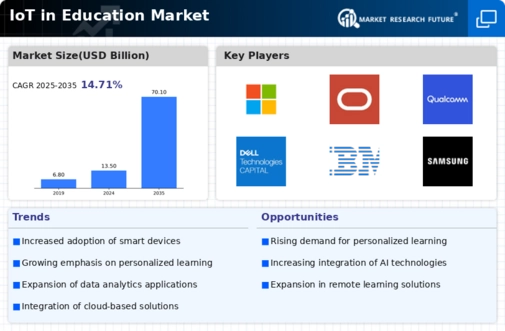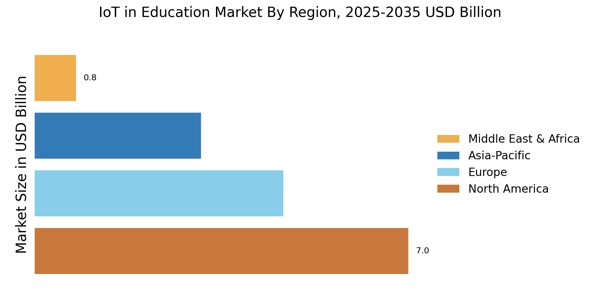Advancements in Smart Classroom Technologies
The IoT in Education Market is witnessing rapid advancements in smart classroom technologies. These innovations include interactive displays, automated attendance systems, and connected learning tools that enhance the educational experience. The market for smart classroom solutions is anticipated to grow at a compound annual growth rate of 25% over the next five years. By integrating IoT devices, educators can create dynamic learning environments that foster collaboration and engagement among students. This trend not only improves the quality of education but also drives the adoption of IoT technologies within educational institutions, thereby contributing to the expansion of the IoT in Education Market.
Growing Focus on Data-Driven Decision Making
The IoT in Education Market is significantly influenced by the growing emphasis on data-driven decision making. Educational institutions are increasingly leveraging IoT technologies to collect and analyze data related to student performance, attendance, and engagement. This data-driven approach enables educators to tailor their teaching methods and improve student outcomes. According to recent studies, institutions utilizing data analytics have reported a 20% increase in student retention rates. As a result, the demand for IoT solutions that facilitate data collection and analysis is expected to rise, further propelling the growth of the IoT in Education Market.
Rising Adoption of Gamification in Education
The IoT in Education Market is increasingly influenced by the rising adoption of gamification strategies in educational settings. Gamification leverages IoT technologies to create interactive and engaging learning experiences that motivate students. Research indicates that gamified learning can enhance student engagement by up to 60%. As educational institutions recognize the benefits of gamification, they are investing in IoT solutions that support game-based learning. This trend is likely to drive the growth of the IoT in Education Market, as more institutions seek to implement innovative teaching methods that resonate with today's tech-savvy learners.
Enhanced Collaboration and Communication Tools
The IoT in Education Market is significantly shaped by the development of enhanced collaboration and communication tools. These tools, powered by IoT technologies, facilitate real-time interaction among students, educators, and parents. The increasing use of platforms that integrate IoT devices allows for more effective communication and collaboration, which is essential for modern educational environments. Studies show that institutions utilizing these tools report improved student engagement and satisfaction. As the demand for collaborative learning experiences continues to grow, the IoT in Education Market is expected to expand, driven by the need for innovative communication solutions.
Increased Demand for Remote Learning Solutions
The IoT in Education Market experiences a notable surge in demand for remote learning solutions. As educational institutions increasingly adopt digital platforms, the integration of IoT devices facilitates seamless communication and collaboration among students and educators. This trend is underscored by the fact that the global e-learning market is projected to reach approximately 375 billion USD by 2026. IoT technologies, such as smart boards and connected devices, enhance the learning experience by providing real-time feedback and interactive content. Consequently, educational institutions are investing in IoT solutions to create engaging and flexible learning environments, thereby driving growth in the IoT in Education Market.


















Leave a Comment